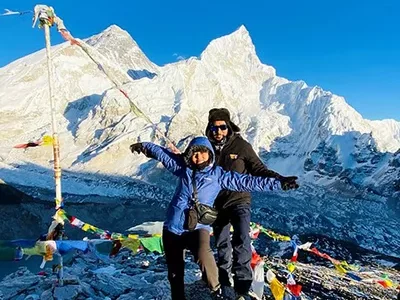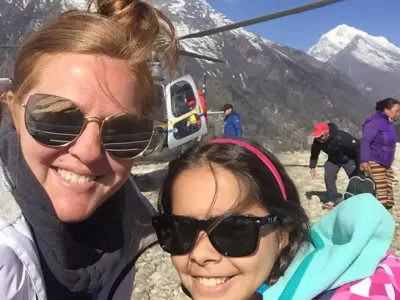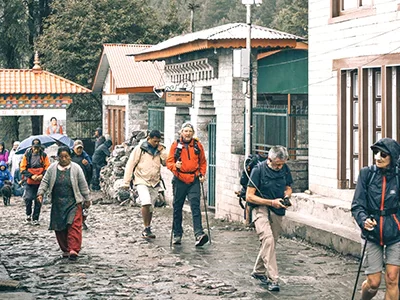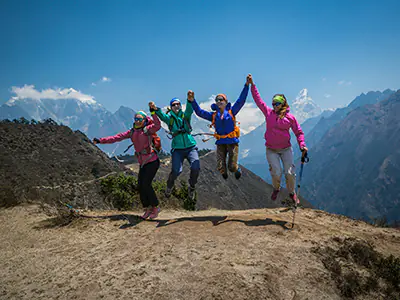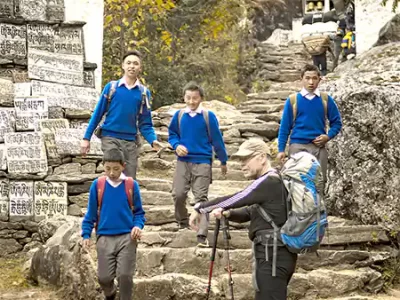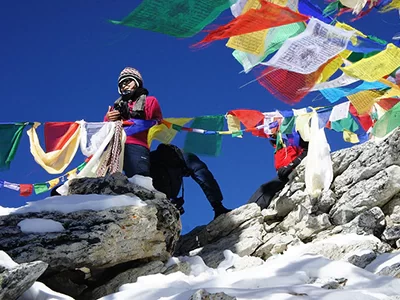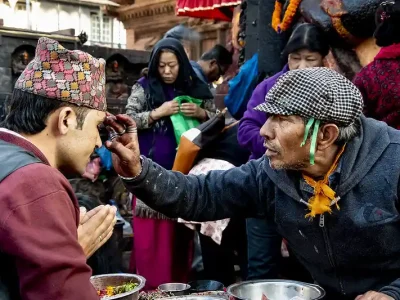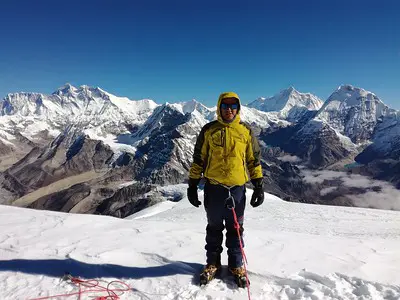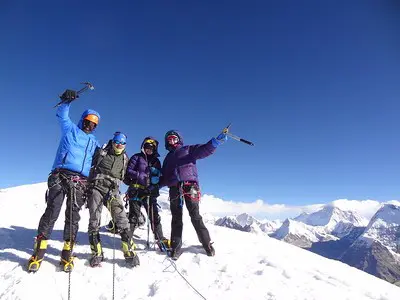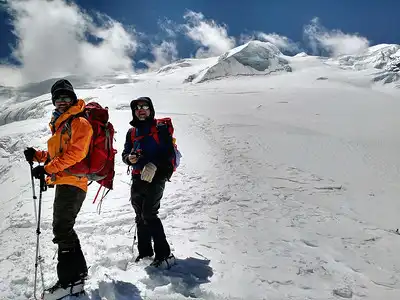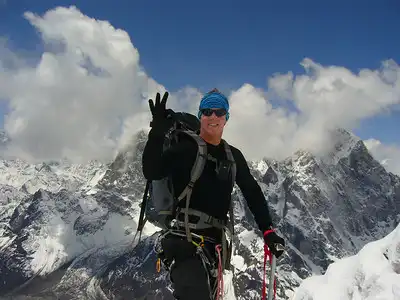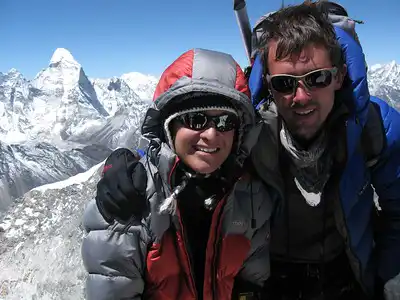Nestled in the heart of the Everest region in Nepal, Kala Patthar stands as a testament to nature’s grandeur. While not as towering as its neighbor, Mount Everest, this iconic peak offers an unparalleled vantage point for witnessing the world’s highest mountain in all its glory.
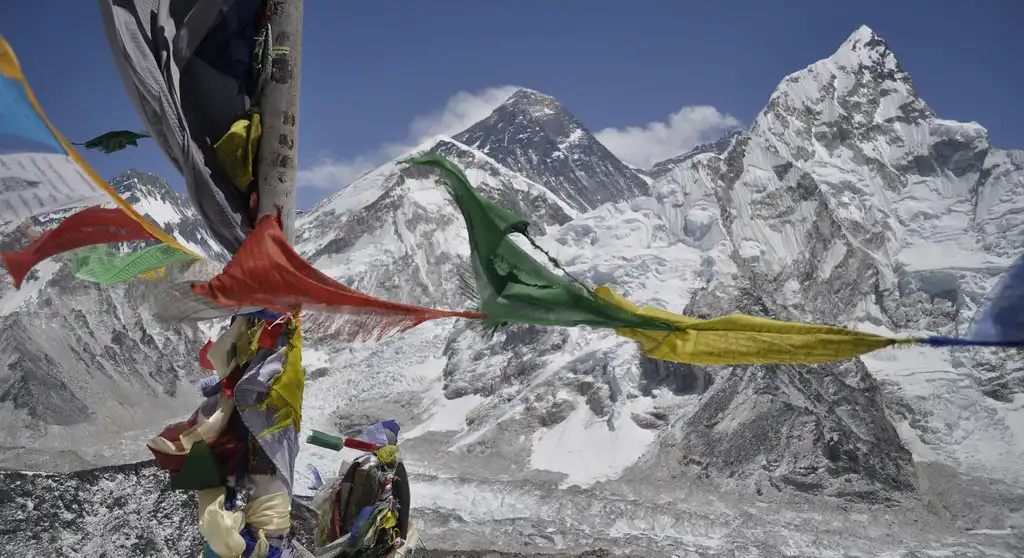
The allure of Kala Patthar lies not just in its proximity to Everest but also in its accessibility. Unlike many viewpoints requiring technical climbing skills, this place welcomes trekkers of various abilities, providing an intimate Himalayan experience.
Why Kala Patthar is a Trekker’s Paradise
- Kala Patthar Elevation: Reaching an elevation of 5,643 meters (18,514 feet), this place provides a breathtaking panorama of the surrounding Himalayan giants, including Everest, Nuptse, Lhotse, and Pumori.
- Kala Patthar Summit: The summit of Kala Patthar is a trekker’s ultimate reward. Standing atop this rocky peak, a 360-degree vista of snow-capped mountains, glaciers, and the sprawling Khumbu Valley below envelops one.
- View of Everest from Kala Patthar: Everest from Kalla Pattar is nothing short of awe-inspiring. The world’s highest mountain dominates the skyline, its summit seemingly within reach. When viewed from Kala Patthar, Everest’s sheer scale and majesty leave an indelible mark on the observer’s memory.
- Accessibility: This place is typically included in the Everest Base Camp trek itinerary, making it accessible to many trekkers. While challenging, the trail to Kala Patthar is well-trodden and offers stunning scenery.
- Photographic Opportunities: The dramatic landscape of this place provides endless opportunities to capture breathtaking photographs. Whether it’s the sunrise casting a golden glow on Everest or the Milky Way illuminating the night sky, Kalla Pattar is a photographer’s dream.
Everest Base Camp Trek
Everest Base Camp Trek with Helicopter Return
Luxury Everest Base Camp Trek
Kala Patthar: Where Everest’s Grandeur Unfolds
Strategically located along the famed Everest Base Camp trek, Kala Patthar is a must-visit for those yearning for the ultimate Himalayan adventure. Situated just above Gorakshep, the last stop before Everest Base Camp, this peak offers a relatively short but incredibly rewarding climb, culminating in an awe-inspiring vista.
Witness the World’s Roof: Kala Patthar’s Significance
Kala Patthar’s allure lies in its extraordinary vantage point. Though not as towering as its neighboring peaks, this rocky summit provides an unrivaled view of Mount Everest, the world’s most celebrated mountain.
- Elevation and Panorama:
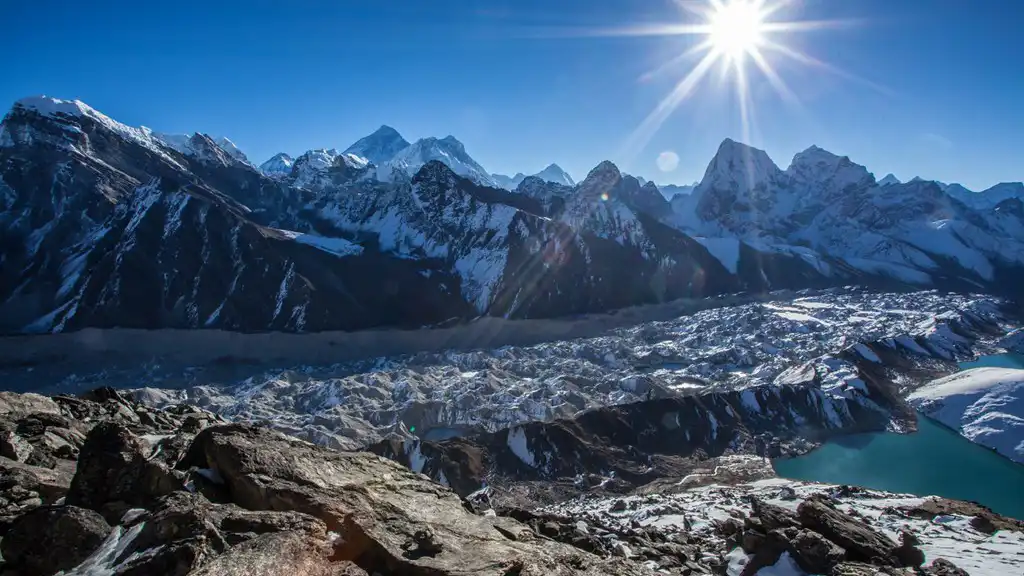
At a remarkable 5,643 meters (18,514 feet) above sea level, Kala Patthar unveils a breathtaking panorama of surrounding Himalayan giants, including Everest, Nuptse, Lhotse, and Pumori.
- Summit Spectacle: From Kala Patthar’s summit, a 360-degree view surrounds you with snow-capped peaks, glaciers, and the vast Khumbu Valley below.
- Everest’s Majesty: Witnessing Everest from Kala Patthar is an experience that transcends words. The world’s highest mountain dominates the skyline, its summit seemingly close enough to touch.
- Glacial Grandeur: This place also showcases the impressive Khumbu Glacier, a colossal river of ice winding through the valley. Observing the glacier’s dynamic movements is a humbling reminder of nature’s raw power and beauty.
Accessibility Meets Adventure
One of Kala Patthar’s most attractive qualities is its accessibility. Unlike other viewpoints in the region requiring technical climbing skills, trekkers of various abilities can reach Kalla Pattar. Though steep and challenging, the trail is well-established and offers stunning scenery.
Reaching the summit is a fulfilling accomplishment, not solely for the physical challenge but also for the breathtaking reward that awaits. The blend of stunning landscapes, accessibility, and the unparalleled view of Everest and the Khumbu Glacier solidifies Kala Patthar’s status as an essential destination for any Everest Base Camp trekker.
Kala Patthar Elevation: Reaching New Heights in the Himalayas
Kala Patthar, towering at 5,545 meters (18,192 feet), offers trekkers in the Everest region one of the highest accessible points without specialized climbing equipment. This altitude, while achievable, comes with its own set of hurdles and incredible rewards.
High Altitude Hurdles
Reaching this place peak involves overcoming the challenges posed by high altitude:
- Altitude Sickness: Trekkers may experience symptoms ranging from headaches and nausea to more severe conditions. Proper acclimatization and recognizing your body’s signals are vital.
- Oxygen Deprivation: The air at high altitudes contains less oxygen, making breathing harder and potentially causing fatigue. To combat this, maintain a steady pace and stay hydrated.
- Chilly Conditions: Temperatures can plummet, particularly at night and during early morning summit attempts for sunrise views. Effective layering of clothing is essential.
Rewards That Soar Above
Despite the challenges, reaching Kalla Pattar’s summit offers unparalleled rewards:
- Unforgettable Vistas: The 360-degree panorama from the summit is truly breathtaking. You’ll witness Everest, Nuptse, Lhotse, Pumori, and the expansive Khumbu Glacier in all their glory.
- Personal Triumph: Reaching such a high altitude is a significant personal accomplishment, boosting your confidence and creating lasting memories.
- Sunrise Magic: Many trekkers time their climb for sunrise, experiencing the first light paint the Himalayan giants in a golden spectacle – a sight you’ll never forget.
Comparing Elevations on the Everest Trek
Kala Patthar’s altitude stands out when compared to other significant points along the Everest Base Camp trek:
- Everest Base Camp (5,364 meters):
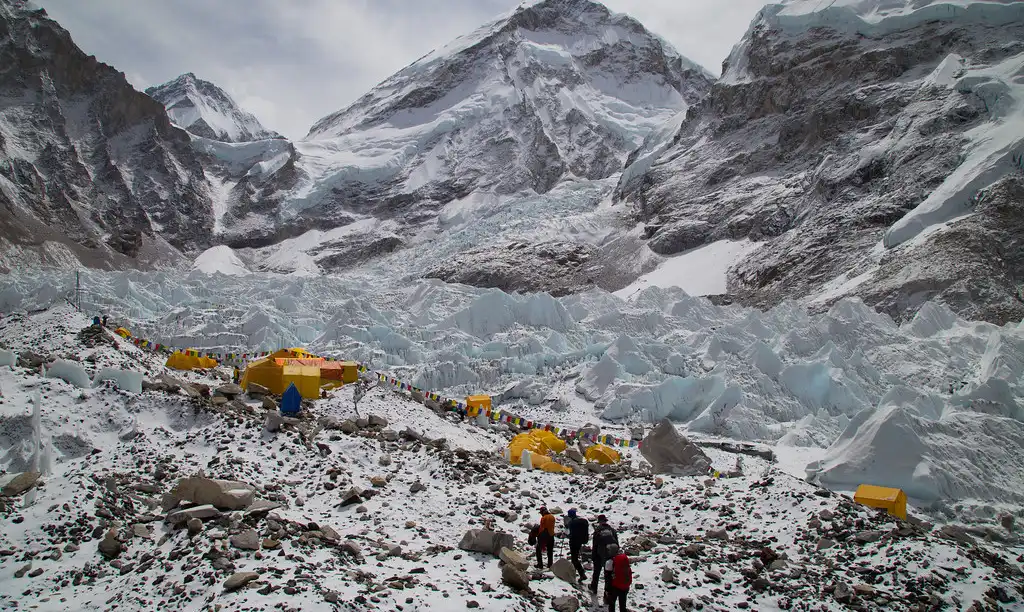
Though slightly lower, Everest Base Camp offers a close encounter with the Khumbu Icefall and the starting point for Everest expeditions.
- Gorakshep (5,164 meters): This final settlement before Everest Base Camp serves as the launchpad for the Kala Patthar climb.
- Namche Bazaar (3,440 meters): A well-known acclimatization stop, Namche Bazaar boasts stunning vistas and a glimpse into Sherpa culture.
Everest Base Camp Trek for Beginners
Everest Panorama Trek
Everest High Pass Trek
Kala Patthar Summit: Conquering the Climb, Capturing the Moment
Reaching the summit of Kala Patthar is a triumph that blends physical exertion with the awe-inspiring beauty of the Himalayas. The final ascent, while challenging, is an experience that trekkers cherish for a lifetime.
The Final Push: What to Expect
The trek to Kalla Pattar’s summit involves a steep, rocky climb. The high altitude and thin air make each step a conscious effort. However, the breathtaking views along the way provide ample motivation to keep moving forward.
- Weather Conditions: Be prepared for unpredictable weather, even during the trekking season. Temperatures can drop significantly, especially at night and in the early morning. Winds can also pick up, adding another layer of challenge. Dress in layers and carry waterproof gear.
- Terrain: The rocky and uneven trail requires sturdy footwear and careful footing. Trekking poles can offer valuable support and stability.
- Best Time for the Trek: Most trekkers aim for sunrise or sunset to witness the spectacular interplay of light and shadow on the surrounding peaks. The sunrise view of Everest bathed in golden light is particularly iconic.
The Summit Experience: A Feast for the Senses
Reaching the summit of this place is an exhilarating moment. The 360-degree panorama that unfolds before you is nothing short of breathtaking.
- Kala Patthar Elevation Advantage: At 5,545 meters (18,192 feet), you’ll stand higher than Everest Base Camp, gaining a unique perspective on the world’s tallest mountain.
- View of Everest from Kala Patthar: The view of Everest from Kala Patthar is awe-inspiring. The mountain dominates the skyline, its summit appearing closer than ever.
- Himalayan Panorama: Beyond Everest, the panorama includes other giants like Lhotse, Nuptse, and Pumori, along with the sprawling Khumbu Glacier.
Tips for a Successful Summit
- Acclimatization: Proper acclimatization is the key to minimizing the risk of altitude sickness. Take rest days, ascend gradually, and stay hydrated.
- Start Early: Whether aiming for sunrise or sunset, start your trek early to allow ample time for the ascent and enjoy the summit’s views.
- Pack Essentials: Carry warm clothing, water, snacks, a headlamp (if trekking in the dark), and a camera to capture the unforgettable scenery.
- Pace Yourself: Listen to your body and take breaks as needed. Despite the challenging climb, the payoff is extraordinary.
View from Kala Patthar: A Himalayan Spectacle
Kala Patthar is renowned for its panoramic vistas, but the view of Mount Everest truly steals the show. From this vantage point, the world’s highest mountain unveils its full glory, leaving an indelible mark on every observer. The sweeping panorama encompasses a multitude of Himalayan giants, each contributing to a scene of unparalleled beauty.
- Mount Everest: The show’s undisputed star, Everest, dominates the skyline with its snow-capped peak seemingly close enough to touch. When viewed from Kalla Pattar, this natural wonder’s sheer scale and majesty evoke a sense of awe and wonder.
- Nuptse, Lhotse, and Pumori: These neighboring peaks frame Everest, creating a dramatic and awe-inspiring composition. With its sharp, triangular peak, Nuptse stands proudly beside Everest, while Lhotse, the fourth-highest mountain in the world, looms majestically in the distance. Pumori, another prominent peak, adds to the grandeur of the scene.
- Khumbu Glacier: The vast Khumbu Glacier, a river of ice snaking its way through the valley, is also visible from this place.
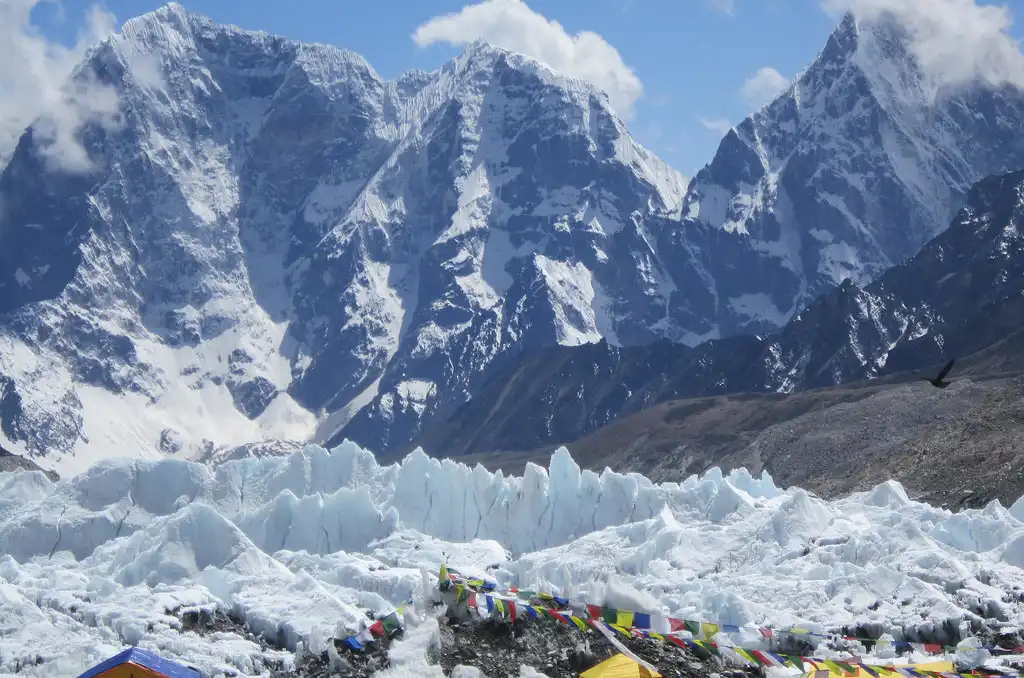
Witnessing the glacier’s dynamic movement is a humbling reminder of nature’s power and the ever-changing landscape of the Himalayas.
- Khumbu Valley: The sprawling Khumbu Valley, dotted with Sherpa villages and monasteries, provides a contrasting foreground to the towering peaks. A tapestry of colorful prayer flags fluttering in the wind enhances the cultural richness of the scene.
Why Kala Patthar Offers the Best View of Everest
Kala Patthar’s unique vantage point sets it apart from other viewpoints in the Everest region, including Everest Base Camp.
- Elevation Advantage: At 5,545 meters (18,192 feet), Kala Patthar stands taller than Everest Base Camp, providing a more comprehensive and unobstructed view of Everest’s summit. This elevation allows you to appreciate the full scale and grandeur of the mountain.
- Summit to Summit Connection: From Kalla Pattar, you can trace the Northeast Ridge route climbers take to reach Everest’s summit. By seeing the climbing route, you can better imagine the climbers’ struggles and triumphs.
- Crystal-Clear Views: The air at this place is often apparent, especially in the early morning and late afternoon. The viewpoint provides exceptional views of Everest’s intricate details, including its glaciers, icefalls, and rock formations. The clarity of the view enhances the overall experience, making you feel closer to the mountain than ever before.
Choosing the Ideal Time
The ideal time for your Kala Patthar trek hinges on your preferences for weather, crowds, and the overall experience. Two seasons, however, generally offer the most favorable conditions:
Spring (March-May)
- Clear Skies, Vibrant Views: Spring delivers stable weather and clear skies, revealing breathtaking vistas of the Himalayan peaks. The trails come alive with colorful wildflowers, especially rhododendrons, painting the landscape in vibrant hues.
- Comfortable Temperatures: Enjoy mild temperatures during the day, perfect for trekking. Remember, nights and early mornings can still be chilly at Kala Patthar’s high altitude.
- Popular Season: Spring is the peak trekking season in the Everest region. Anticipate more fellow trekkers on the trails and at teahouses.
Autumn (September-November)
- Post-Monsoon Clarity: The monsoon rains cleanse the air, leaving behind crisp, clear skies and stunning mountain views. The autumn foliage adds a touch of gold to the scenery.
- Pleasant Weather: Temperatures remain moderate in autumn, with cooler nights and mornings.
- Festival Vibes: Autumn aligns with several major festivals in Nepal, offering a chance to experience the local culture and traditions.
Weather’s Role in Your Experience
Weather significantly impacts your trekking experience, especially at high altitudes like Kalla Pattar.
- Visibility is Key: Clear skies are essential for enjoying the panoramic views from the summit. Clouds or fog can obscure the mountains, impacting your experience.
- Trail Conditions: Rain or snow often results in slippery and challenging trails. Expect muddy trails and potential landslides during the monsoon season (June-August).
- Comfort Matters: Extreme cold or heat can affect your trekking performance and enjoyment. Layer your clothing for optimal comfort in varying conditions.
Getting Ready for Kala Patthar: Fitness and Altitude Acclimatization
Conquering Kala Patthar’s peak at 5,545 meters (18,192 feet) demands physical and mental readiness. The high altitude and demanding terrain necessitate a solid physical condition and gradual acclimatization for a safe and rewarding trek.
Train Your Body for the Challenge
Start preparing well in advance of your trek. Regular cardio workouts such as hiking, running, or cycling will boost your endurance and strengthen your legs. Build strength in your core and legs to conquer uneven trails while carrying your backpack. Follow these specific tips:
- Start Early: Begin your training several months before your trek. Gradually boost your workout intensity and duration to enhance stamina.
- Mimic the Terrain: Incorporate hill climbs or stair workouts into your training to simulate the uphill challenges you’ll face.
- Pack Smart: A lighter backpack makes for an easier trek. Pack only essentials and avoid carrying unnecessary weight.
- Listen to Your Body: Pay close attention to how you feel during training and on the trek. Don’t push yourself beyond your limits; take rest days as needed.
Acclimatization: Your Key to High-Altitude Success
Acclimatization allows your body to adapt to the lower oxygen levels at high altitudes. Preventing altitude sickness, a potentially severe condition at elevations over 2,500 meters, is crucial.
- Ascend Gradually: The Everest Base Camp trek itinerary incorporates acclimatization days, ensuring a gradual ascent with extra time spent at higher altitudes to help your body adjust.
- Hydrate and Nourish: Staying well-hydrated and eating a balanced carbohydrate-rich diet is vital for acclimatization and maintaining energy levels.
- Rest and Recover: Get sufficient rest, particularly during acclimatization days. Avoid overexerting yourself, and be mindful of your body’s signals.
- Know the Signs: Symptoms of altitude sickness include headache, nausea, fatigue, dizziness, and difficulty breathing. If you experience these, inform your guide immediately and consider descending to a lower altitude.
The Trekking Route to Kala Patthar
The trek to Kala Patthar typically begins in Gorakshep, the last stop on the Everest Base Camp trail. Although the altitude makes the trek arduous, the mesmerizing scenery makes it worthwhile. Here’s a breakdown of the route:
Gorakshep to Kala Patthar
The trek starts from Gorakshep (5,164 meters) and takes around 2 to 3 hours to reach the top of this place. The path is steep and rocky, so you must watch your footing. The views improve as you ascend, with Everest and surrounding peaks becoming more visible. The summit offers a breathtaking panorama of soaring mountains, glistening glaciers, and the expansive Khumbu Valley. Key Stops Along the Way:
- Everest Base Camp (5,364 meters): Located just a few kilometers away, many trekkers visit Everest Base Camp before heading to Kala Patthar. After this stop, spending the night in Gorakshep lets you tackle the Kalla Pattar climb early in the morning.
- Gorakshep:
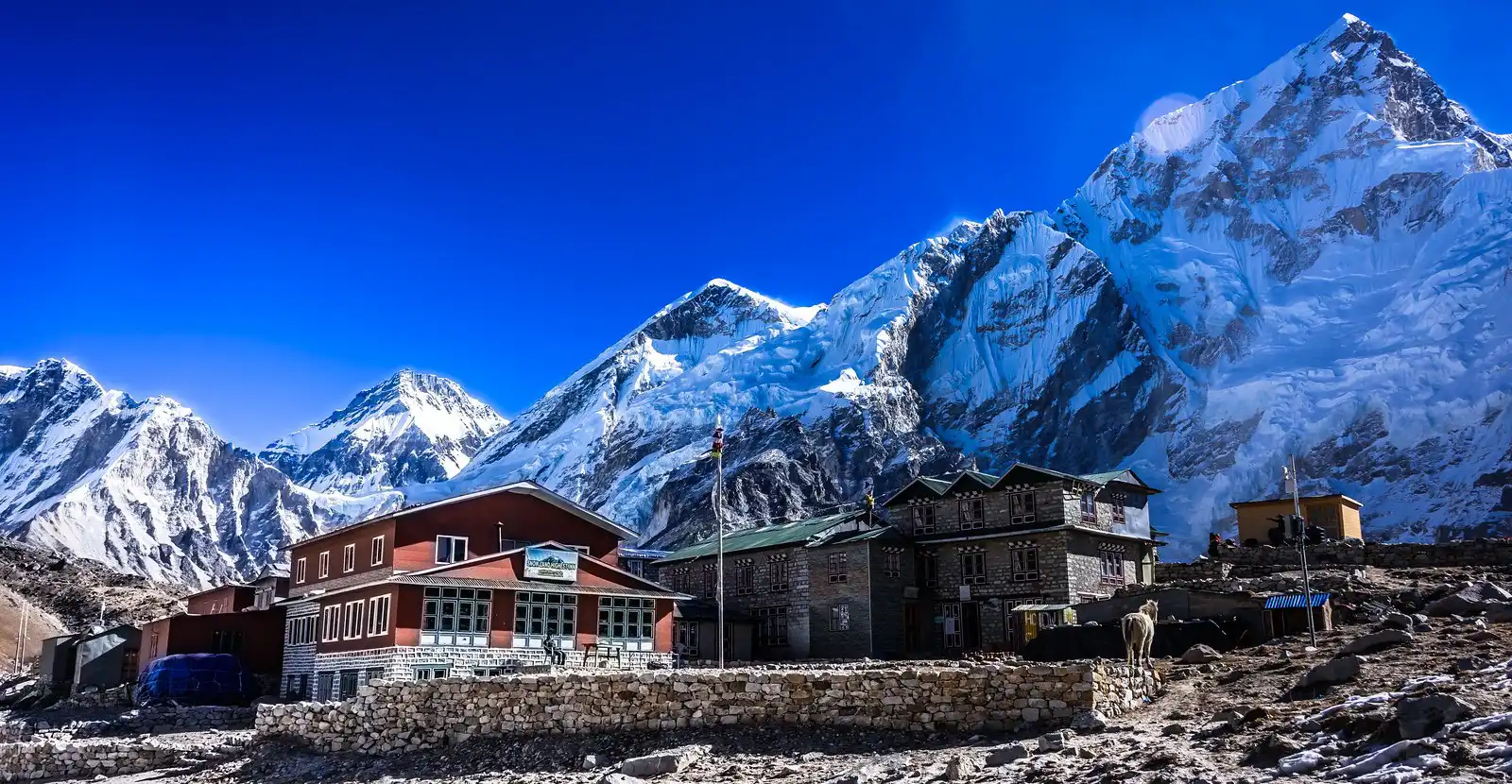
This small settlement provides basic accommodations and a familiar resting spot for those planning to climb Kala Patthar.
Suggested Itinerary for Trekking Kala Patthar
Here’s a sample itinerary for including Kala Patthar in your Everest Base Camp trek:
Day 1: Lukla to Phakding
- Begin your adventure with a flight to Lukla and a trek to Phakding.
Day 2: Phakding to Namche Bazaar
- Continue your trek to Namche Bazaar (3,440 meters), a bustling hub in the Khumbu region. This location serves as a critical acclimatization point.
Day 3: Acclimatization in Namche Bazaar
- Spend the day acclimatizing. Explore the town or take a short hike to help your body adjust to the higher elevation.
Day 4: Namche Bazaar to Tengboche
- Trek from Namche to Tengboche (3,860 meters). The famous Tengboche Monastery provides a remarkable backdrop with a stunning view of Everest.
Day 5: Tengboche to Dingboche
- Head to Dingboche (4,410 meters), where you’ll notice the air thinning. Take it easy and enjoy the landscape.
Day 6: Acclimatization in Dingboche
- Spend the day in Dingboche to help your body adjust to the altitude. Consider taking a short hike to prepare for higher elevations.
Day 7: Dingboche to Lobuche
- Trek to Lobuche (4,940 meters). The landscape becomes more rugged and dramatic as you approach Everest Base Camp.
Day 8: Lobuche to Gorakshep and Everest Base Camp
- Reach Gorakshep, then take a side trip to Everest Base Camp. Afterward, return to Gorakshep for the night.
Day 9: Climb to Kala Patthar and Descend to Pheriche
- Start early and make your way to the summit of Kala Patthar. Take in the best views of Everest and the surrounding Himalayan giants. Afterward, head back to Gorakshep and continue down to Pheriche (4,371 meters) for the night.
Day 10: Pheriche to Namche Bazaar
- Retrace your steps through the beautiful Khumbu valleys back to Namche Bazaar.
Day 11: Namche Bazaar to Lukla
- Finish your trek with a return to Lukla. Enjoy the final stretch of your trek through the mountains.
Day 12: Fly Back to Kathmandu
- Take an early morning flight from Lukla back to Kathmandu.
Essential Gear for the Trek
The right equipment can significantly enhance your high-altitude trekking experience in unpredictable conditions. Here’s what you’ll need:
Clothing
- Warm Layers: Pack thermal base layers, a fleece jacket, and a down jacket for insulation. Temperatures drop quickly, especially at night and during early morning climbs.
- Waterproof Outerwear: A waterproof jacket and pants protect you from unexpected rain or snow during your trek.
- Trekking Pants: Choose comfortable, quick-drying trekking pants. Convertible pants that turn into shorts are a versatile choice for fluctuating temperatures.
- Sturdy Boots: Invest in waterproof hiking boots that offer good ankle support. Proper boots are crucial for safely navigating rocky paths and uneven terrain.
- Cold-Weather Gear: Bring a warm hat that covers your ears and insulated gloves to protect your extremities from the cold.
- Sun Protection: Don’t forget sunglasses and high-SPF sunscreen, as the sun’s intensity increases with altitude.
Other Essential Items
- Trekking Poles: Use trekking poles to maintain balance and reduce knee strain, especially when descending steep sections.
- Headlamp: Carry a headlamp or flashlight for early morning or late evening treks when visibility is low.
- Water Purification: Bring a reusable water bottle and purify water with tablets or a filter.
- First-Aid Kit: Keep a basic first-aid kit on hand to manage minor injuries or health issues during your trek.
- Camera: Remember to capture the stunning scenery with your camera and pack an extra battery or power bank, as cold temperatures can quickly drain battery life.
Respect for Culture and the Environment
Trekking through the Khumbu region provides an opportunity to connect with Sherpa culture and the pristine Himalayan environment. Adopt responsible trekking practices to protect these treasures.
Cultural Considerations
- Follow Local Customs: Learn about the local customs and traditions, and show respect by dressing modestly and asking for permission before photographing people. Be exceptionally mindful when visiting religious sites.
- Support Local Businesses: Stay in locally-owned teahouses, purchase local products, and hire local guides and porters. Supporting the local economy empowers the communities you pass through.
- Learn Basic Phrases: A few simple Nepali phrases can help you connect with locals and enrich your experience.
Environmental Responsibility
- Leave No Trace: Carry your trash out with you and leave no trace of your trek on the trail.
- Reduce Plastic Waste: Opt for refillable water bottles and purification tablets or filters to reduce plastic waste.
- Stick to the Path: Stay on marked trails to protect the local ecosystem and prevent soil erosion.
- Respect Wildlife: Observe animals from afar to avoid disrupting their natural behavior.
Kala Patthar: A Himalayan Highlight, Your Gateway to Everest
Ascending Kala Patthar isn’t simply a hike; it’s a pilgrimage for those yearning for an up-close encounter with the world’s tallest peak. This experience etches itself into your memory, a testament to the Himalayas’ raw beauty and power.
Why Kala Patthar Beckons
- Altitude without the Climb: At 5,545 meters (18,192 feet), Kalla Pattar provides a high-altitude thrill without requiring technical climbing skills.
- Everest’s Best Vantage Point: The view of Everest’s summit from this peak is often considered more awe-inspiring than the one seen from Base Camp. Witness a panorama that includes Everest, Nuptse, Lhotse, Pumori, and the sprawling Khumbu Glacier.
- Summit Triumph: Standing atop this place symbolizes victory, a reward for your physical and mental preparation.
- Accessibility for All: Though challenging, the trek is achievable for most with proper fitness and acclimatization, opening the door to high-altitude adventure.
Why You Must Experience Kala Patthar
- Unforgettable Vistas: The panoramic views, especially of Everest, will leave you speechless. Capture sunrise or sunset painting the peaks gold – an image you’ll treasure forever.
- Personal Achievement: Reaching such a height and gazing upon the world’s tallest mountain instills pride and accomplishment.
- Cultural Connection: The trek provides a window into the Khumbu region’s unique Sherpa culture and traditions.
- Adventure Awaits: Kala Patthar is a gateway to high-altitude adventure, accessible to many trekkers, even those new to mountaineering.

